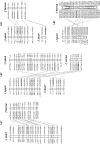Linkage maps of the dwarf and Normal lake whitefish (Coregonus clupeaformis) species complex and their hybrids reveal the genetic architecture of population divergence
- PMID: 17110497
- PMCID: PMC1774998
- DOI: 10.1534/genetics.106.061457
Linkage maps of the dwarf and Normal lake whitefish (Coregonus clupeaformis) species complex and their hybrids reveal the genetic architecture of population divergence
Abstract
Elucidating the genetic architecture of population divergence may reveal the evolution of reproductive barriers and the genomic regions implicated in the process. We assembled genetic linkage maps for the dwarf and Normal lake whitefish species complex and their hybrids. A total of 877 AFLP loci and 30 microsatellites were positioned. The homology of mapped loci between families supported the existence of 34 linkage groups (of 40n expected) exhibiting 83% colinearity among linked loci between these two families. Classes of AFLP markers were not randomly distributed among linkage groups. Both AFLP and microsatellites exhibited deviations from Mendelian expectations, with 30.4% exhibiting significant segregation distortion across 28 linkage groups of the four linkage maps in both families (P < 0.00001). Eight loci distributed over seven homologous linkage groups were significantly distorted in both families and the level of distortion, when comparing homologous loci of the same phase between families, was correlated (Spearman R = 0.378, P = 0.0021). These results suggest that substantial divergence incurred during allopatric glacial separation and subsequent sympatric ecological specialization has resulted in several genomic regions that are no longer complementary between dwarf and Normal populations issued from different evolutionary glacial lineages.
Figures











Similar articles
-
Contrasting patterns of mitochondrial DNA and microsatellite introgressive hybridization between lineages of lake whitefish (Coregonus clupeaformis); relevance for speciation.Mol Ecol. 2001 Apr;10(4):965-85. doi: 10.1046/j.1365-294x.2001.01252.x. Mol Ecol. 2001. PMID: 11348504
-
The genetic basis of intrinsic and extrinsic post-zygotic reproductive isolation jointly promoting speciation in the lake whitefish species complex (Coregonus clupeaformis).J Evol Biol. 2006 Nov;19(6):1979-94. doi: 10.1111/j.1420-9101.2006.01150.x. J Evol Biol. 2006. PMID: 17040396
-
Mapping phenotypic, expression and transmission ratio distortion QTL using RAD markers in the Lake Whitefish (Coregonus clupeaformis).Mol Ecol. 2013 Jun;22(11):3036-48. doi: 10.1111/mec.12127. Epub 2012 Nov 26. Mol Ecol. 2013. PMID: 23181719
-
The genetic architecture of ecological speciation and the association with signatures of selection in natural lake whitefish (Coregonus sp. Salmonidae) species pairs.Mol Biol Evol. 2007 Jun;24(6):1423-38. doi: 10.1093/molbev/msm066. Epub 2007 Apr 2. Mol Biol Evol. 2007. PMID: 17404398
-
Effects of crossovers between homeologs on inheritance and population genomics in polyploid-derived salmonid fishes.J Hered. 2015 May-Jun;106(3):217-27. doi: 10.1093/jhered/esv015. Epub 2015 Apr 2. J Hered. 2015. PMID: 25838153 Review.
Cited by
-
Chromosome rearrangements, recombination suppression, and limited segregation distortion in hybrids between Yellowstone cutthroat trout (Oncorhynchus clarkii bouvieri) and rainbow trout (O. mykiss).BMC Genomics. 2013 Aug 22;14:570. doi: 10.1186/1471-2164-14-570. BMC Genomics. 2013. PMID: 23968234 Free PMC article.
-
Comparative High-Density Linkage Mapping Reveals Conserved Genome Structure but Variation in Levels of Heterochiasmy and Location of Recombination Cold Spots in the Common Frog.G3 (Bethesda). 2017 Feb 9;7(2):637-645. doi: 10.1534/g3.116.036459. G3 (Bethesda). 2017. PMID: 28040782 Free PMC article.
-
Coding Gene Single Nucleotide Polymorphism Mapping and Quantitative Trait Loci Detection for Physiological Reproductive Traits in Brook Charr, Salvelinus fontinalis.G3 (Bethesda). 2012 Mar;2(3):379-92. doi: 10.1534/g3.111.001867. Epub 2012 Mar 1. G3 (Bethesda). 2012. PMID: 22413092 Free PMC article.
-
A hybrid genetic linkage map of two ecologically and morphologically divergent Midas cichlid fishes (Amphilophus spp.) obtained by massively parallel DNA sequencing (ddRADSeq).G3 (Bethesda). 2013 Jan;3(1):65-74. doi: 10.1534/g3.112.003897. Epub 2013 Jan 1. G3 (Bethesda). 2013. PMID: 23316439 Free PMC article.
-
On the origin of species: insights from the ecological genomics of lake whitefish.Philos Trans R Soc Lond B Biol Sci. 2010 Jun 12;365(1547):1783-800. doi: 10.1098/rstb.2009.0274. Philos Trans R Soc Lond B Biol Sci. 2010. PMID: 20439281 Free PMC article. Review.
References
-
- Angers, B., L. Bernatchez, A. Angers, L. Desgroseillers, 1995. Specific microsatellite loci for brook charr (Salvelinus fontinalis Mitchill) reveals strong population subdivision on microgeographic scale. J. Fish Biol. 47(Suppl. A): 177–185.
-
- Bailey, N. T. J., 1949. The estimation of linkage with differential viability, II and III. Heredity 3: 220–228. - PubMed
-
- Bensch, S., and M. Akesson, 2005. Ten years of AFLP in ecology and evolution: Why so few animals? Mol. Ecol. 14: 2899–2914. - PubMed
Publication types
MeSH terms
LinkOut - more resources
Full Text Sources

